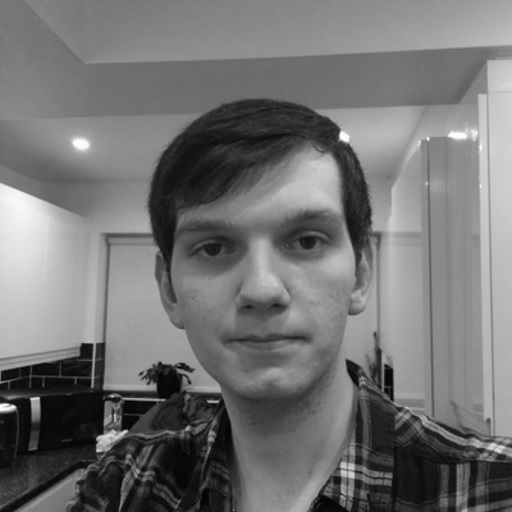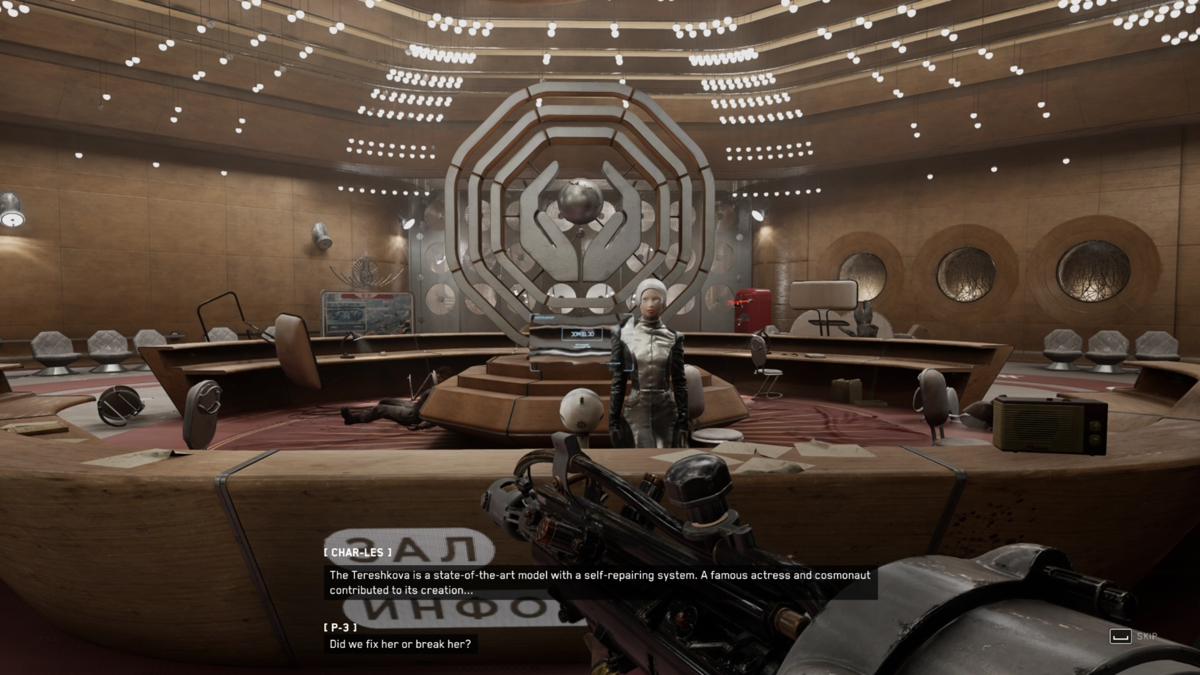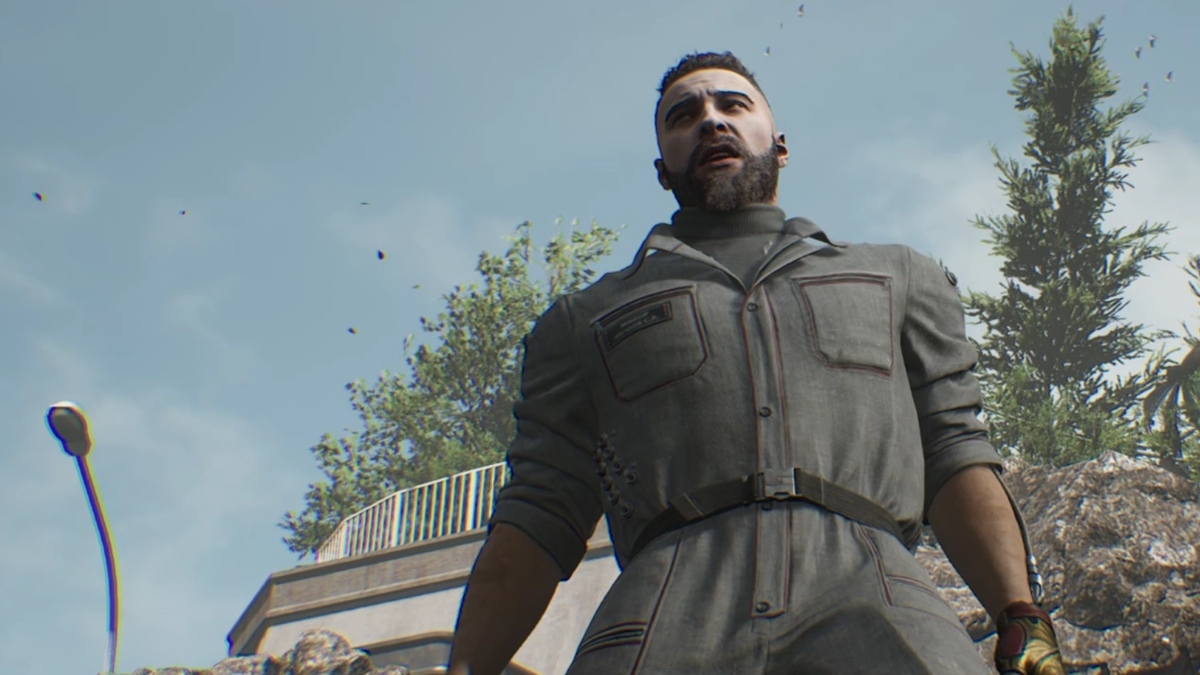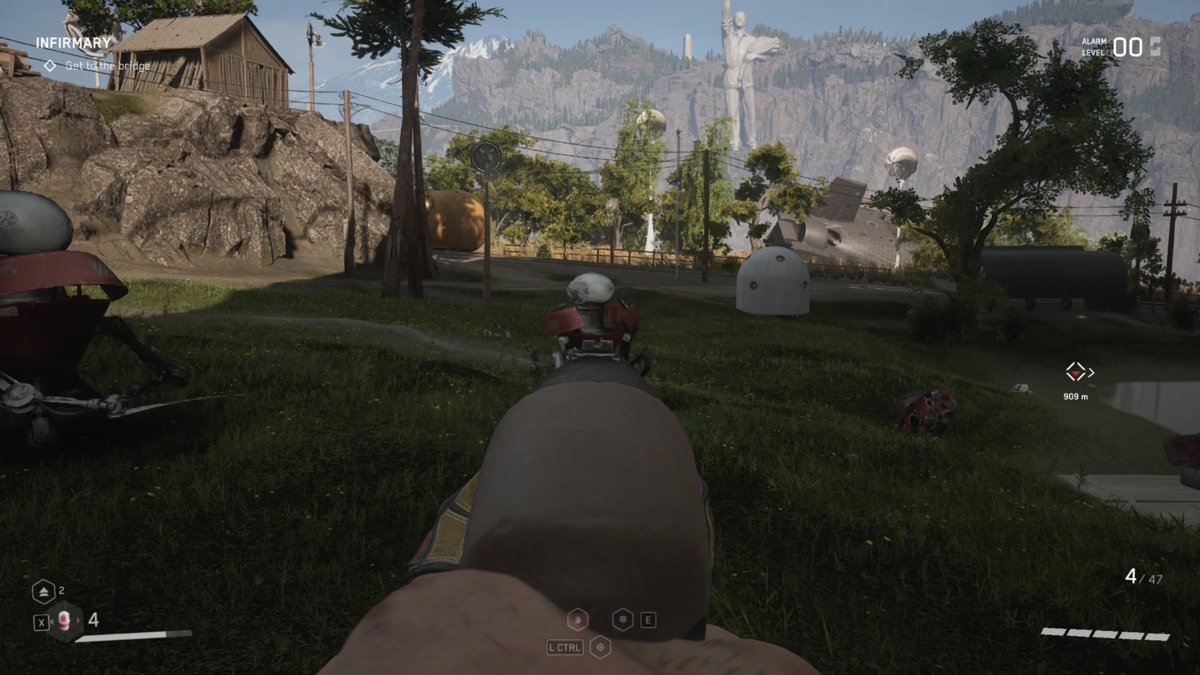February hasn’t been short of controversial releases. Coming fresh off of the back of Hogwarts Legacy, Atomic Heart has once again upset some people due to its alleged links to Russia. These connections could be a deal-breaker to some, but my time playing suggests that the call for a boycott may be unnecessary.
Atomic Heart takes place in a futuristic Soviet Russia that never fell. You play as Major Sergei Nechaev, a Russian officer who operates as the right-hand man of Dmitry Sechenov. Nachaev also fights alongside his sentient glove named Charles. Sechenov is the active Minister of Industry, but he has goals to become much more and will do whatever it takes to get there.
Without delving too deep into spoilers, the story of Atomic Heart is one that explores a variety of political topics. Certainly, on the surface, it does glorify communism, but this is done so as the story is told from Nechaev’s point of view. The major is a loyal dog who wouldn’t dare doubt Sechenov, as he feels that he owes him. As the story progresses, flaws in Sechenov’s leadership begin to show and those around him begin to question his true nature.
Of course, if the setting and mysterious origins of Atomic Heart make you uncomfortable, there’s nothing wrong with passing on it. However, calling Atomic Heart pro-communism would be like calling Wolfenstein pro-Nazi. It’s a gross oversimplification of the undertones and subtleties that focus more on the false utopia being fed to the citizens than the glorification of Soviet Russia.
Impressive scope
Looking past its origins, Atomic Heart is an ambitious game. The scale and focus of its storytelling and world-building are inspired by the likes of BioShock Infinite. It doesn’t quite deliver the same hard-hitting narrative, but for Mundfish’s first attempt, I think it can be proud of its efforts.
The utopian Soviet Union setting won’t be something that everyone buys into, but it’s hard to deny that it’s at least visually attractive as a game. The epic structures and gorgeous landscapes make you want to explore more and see what the world has to offer. It draws you in and manages to deliver on a lot of its potential.
Unfortunately, the storytelling is hurt by the existence of Major Nechaev. Our protagonist is obnoxious and says everything you don’t want him to. There are several occasions where Charles tries to offer interesting insight and, Major tells him to shut up. For a game that seems to care so much about its world-building, it’s bizarre how hard it tries to stop you from finding out more about its world.
Things are only made worse by Major’s personality, which is an unlikable mix of annoying and naïve. His unwillingness to learn about his surroundings and his dull one-liners don’t make for a memorable protagonist. Or at the very least, if he is memorable, it’s for all the wrong reasons.
No FOV in 2023
One area where Atomic Heart excels is its presentation which is nothing short of spectacular. The cutscenes are gorgeous and the environments are breathtaking. Even if you aren’t overly interested in the story, there’s an awful lot of eye candy that anyone can appreciate. This is a beautiful game that delivers on almost all technical fronts despite its lack of ray tracing.
I say almost all, because Mundfish has made an astonishing decision. Despite the PC port being fine enough, running well, and supporting options like Nvidia DLSS, there is no customizable FOV. The default FOV seems to sit around 85, which isn’t unplayable but it’s not pleasant either. Mundfish justifies this decision by claiming that the default FOV in Atomic Heart is ” higher than many other games,” but on PC that’s just not true.
Throughout my playthrough, Atomic Heart didn’t exactly prove itself to be the most stable game either. I experienced crashes every 2-3 hours which, while not horrific, did hurt my immersion somewhat. Thankfully, Atomic Heart implements a generous autosave mechanic so I never lost any meaningful progress.
Violent recycling
Gameplay-wise, Atomic Heart delivers on some fronts and is exhausting on others. The positives revolve around its diverse abilities and the fun gunplay. When you are fighting enemies it feels great, and having so many tools to do so keeps things interesting.
There’s something incredibly satisfying about getting overcrowded by a group of enemies, lifting them all with Mass Telekinesis, and slamming them into the floor, clearing the room out all at once. When you’re abilities are upgraded, Major feels like a robot-slaying superhero.
It’s a similar story with the guns, which offer all sorts of ways to destroy whoever or whatever is unfortunate enough to get in your way. Be it a hard-hitting shotgun or a mace, or even a goddamn railgun, there is no shortage of ways to rack up kills.
At its best, the combat is gratifying but it does take some time to get there. The early game doesn’t deliver the same level of satisfaction, as your abilities are lackluster and your weapons suck. This also creates an inverted difficulty curve where later upgrades make content easier. I kid you not, the opening lab was probably the hardest of all just because I was forced to rely on a crappy axe with a terrible special attack.
Exploring Facility 3826
Outside of its combat, Atomic Heart misses some shots. The platforming segments are straight out of Hell, and every time one appeared I was just praying for it to end. The game’s limited movement just doesn’t lend itself well to complex platforming.
On the flip side, I enjoyed the side quests and optional content found in the open world. My first impressions of the open world weren’t great, as there are just so many enemies scattered around that it can be hard to explore. However, it grew on me as time went on and I think it does a decent job of breaking up the gameplay between story missions.
The open-world content doesn’t add much to the story, but the rewards from these areas make them worth completing. The biggest draw is that the extended magazines for most guns can be found here, and having a larger magazine helps a ton with Atomic Heart‘s harder fights. It’s just a shame that completing them usually means having to stomach more platforming segments.
An inaccessible adventure
Atomic Heart offers some accessibility, but leaves a lot to be desired. Both Local Malfunction and the harder Armageddon difficulties offer a challenging experience, while Peaceful Atom is there for players who want to focus on the story. Although even Peaceful Atom still requires a reasonable grasp of mechanics and isn’t an ideal story mode difficulty.
The shortcomings are hard to miss with the subtitle options, while artistic, lack more important features like the ability to resize them. Also, there’s no colorblind mode, and don’t expect anything non-standard like being able to disable tinnitus effects or slow down the game while aimed in.
A little overly ambitious
Atomic Heart does a lot right and Mundfish deserves credit for the sheer creativity and ambition on display. The fact that Atomic Heart can draw comparisons to BioShock in the first place is impressive given that this is Mundfish’s first game. Its origins and themes won’t be for everyone, but if you can look past that it’s worth playing.
In saying that, there is no question that feature creep has hurt this game. It tries to do so much at once that it ends up only doing a few things well, most things averagely, and even some things poorly. Even so, if you’re looking for a single-player shooter, you can do a lot worse than Atomic Heart.
Related: The Atomic Heart Controversy & How It Connects to Russia’s War in Ukraine on The Escapist













Published: Feb 20, 2023 01:00 pm